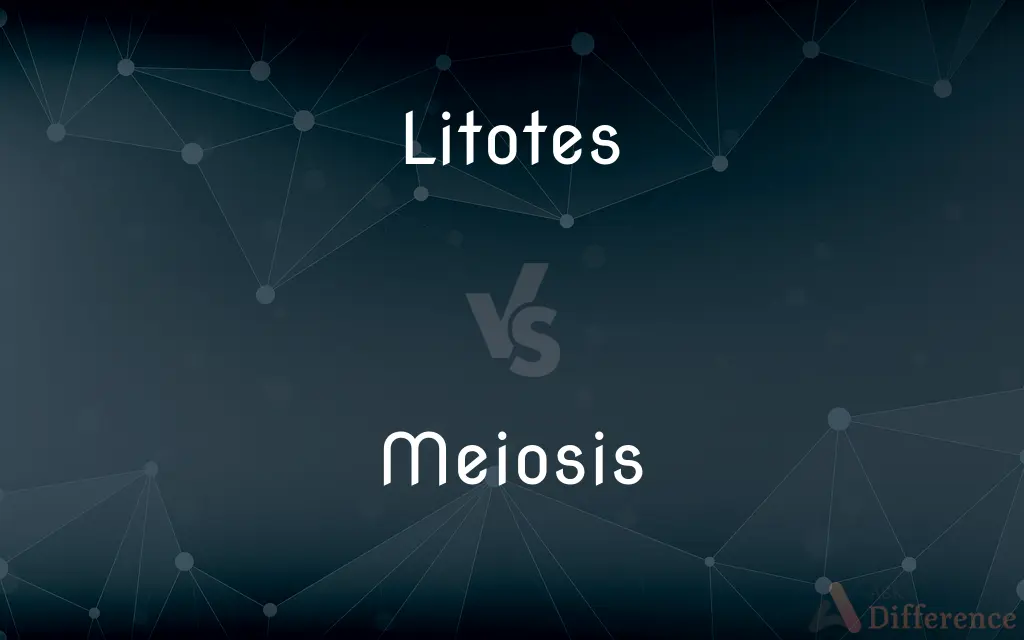Litotes vs. Meiosis — What's the Difference?
Edited by Tayyaba Rehman — By Fiza Rafique — Updated on April 1, 2024
Litotes uses double negatives for understatement, emphasizing a point subtly, whereas meiosis diminishes the importance, often humorously or sarcastically.

Difference Between Litotes and Meiosis
Table of Contents
ADVERTISEMENT
Key Differences
Litotes is a rhetorical figure involving understatement by using double negatives or negating the opposite, subtly emphasizing the actual thought. Meiosis, on the other hand, deliberately understates or diminishes the importance of something, often to humorous or sarcastic effect.
While litotes might say, "He's not bad at singing" to imply someone is quite good, meiosis would describe a disastrous situation as "a slight problem" to downplay its severity or induce humor. This contrast highlights litotes' focus on enhancement through understatement versus meiosis' tendency to belittle or minimize.
Litotes is often employed to convey modesty or soften a statement, making it less direct or boastful, as in "She's not unfamiliar with the subject." Meiosis, conversely, might serve to reduce the perceived importance of something, as in referring to Shakespeare as "a decent playwright," to inject wit or diminish its stature.
In literature, litotes can create a subtle, nuanced effect, encouraging readers to infer the deeper meaning behind the understatement. Meiosis, however, is more likely to be used for comic relief or to convey a character's dismissive attitude towards something supposedly significant.
Understanding the distinction between litotes and meiosis is crucial for interpreting texts accurately, as each employs understatement differently—litotes to affirm positively by negating the negative, and meiosis to trivialize or minimize, often with a dash of humor.
ADVERTISEMENT
Comparison Chart
Definition
Understatement by using double negatives or negating opposite.
Deliberate understatement to diminish importance, often humorously.
Purpose
Emphasize a point subtly, often positively.
Diminish or belittle the importance, often humorously.
Typical Use
To convey modesty, soften statements.
To inject humor, sarcasm, or diminish importance.
Effect
Creates subtlety, encouraging deeper interpretation.
Induces humor, wit, or reduces perceived importance.
Example
"He's not bad at singing" implies skill.
"A slight problem" to understate a disaster.
Compare with Definitions
Litotes
A rhetorical device using double negatives for understatement.
It's not uncommon for him to work late subtly implies it's common.
Meiosis
A figure of speech that intentionally understates something's importance.
He has a bit of a temper minimizes the severity of the temper.
Litotes
Used to express a thought by negating its opposite.
She's not unlike her mother means she resembles her mother.
Meiosis
Can belittle or trivialize.
Einstein was a decent mathematician underplays his genius.
Litotes
Often conveys modesty or understatement.
This dessert isn't bad actually suggests it's quite good.
Meiosis
Often used for humorous or sarcastic effect.
Just a scratch referring to a large dent in a car.
Litotes
Can soften the presentation of a statement.
He's not the worst player on the team suggests some competence.
Meiosis
Adds wit or humor through understatement.
A minor setback for a major failure.
Litotes
Encourages inference and interpretation.
Not the least bit interesting implies it's very interesting.
Meiosis
Used to diminish or make light of situations.
A little disagreement for a full-blown argument.
Litotes
In rhetoric, litotes (, US: or ; also known classically as antenantiosis or moderatour) is a figure of speech and form of verbal irony in which understatement is used to emphasize a point by stating a negative to further affirm a positive, often incorporating double negatives for effect. Litotes is a form of understatement, more specifically meiosis, and is always deliberate with the intention of emphasis.
Meiosis
Rhetorical understatement.
Litotes
A figure of speech consisting of an understatement in which an affirmative is expressed by negating its opposite, as in This is no small problem.
Meiosis
A figure of speech whereby something is made to seem smaller or less important than it actually is.
Litotes
(rhetoric) An ironic figure of speech whereby something is stated by denying its opposite, particularly the negation of a negative quality to say something positive.
Meiosis
Cell division of a diploid cell into four haploid cells, which develop to produce gametes.
Litotes
A diminution or softening of statement for the sake of avoiding censure or increasing the effect by contrast with the moderation shown in the form of expression; a form of understatement; as, " a citizen of no mean city," that is, of an illustrious city; or, "not bad", meaning "good".
Meiosis
Diminution; a species of hyperbole, representing a thing as being less than it really is; understatement; see also litotes.
Litotes
Understatement for rhetorical effect (especially when expressing an affirmative by negating its contrary);
Saying `I was not a little upset' when you mean `I was very upset' is an example of litotes
Meiosis
The cellular process by which a diploid progenitor cell forms haploid gametes, including a division of one diploid cell into two cells, each with one of the homologous sets of chromosomes.
Meiosis
Understatement for rhetorical effect (especially when expressing an affirmative by negating its contrary);
Saying `I was not a little upset' when you mean `I was very upset' is an example of litotes
Common Curiosities
What is litotes?
Litotes is a form of understatement that uses double negatives or negates the opposite to subtly emphasize a point.
What is meiosis?
Meiosis is a rhetorical strategy that diminishes the importance of something, often for humorous or sarcastic effect.
Why are litotes effective in communication?
They are effective for their subtlety, allowing speakers to express modesty or soften their statements, making the message more palatable.
In what contexts might litotes be preferred over meiosis?
Litotes are preferred in formal or modest contexts where the goal is to soften claims or show humility.
Where is meiosis most effectively employed?
Meiosis shines in humorous, sarcastic, or informal settings where the goal is to diminish or poke fun at the importance of something.
How do readers interpret litotes and meiosis?
Interpretation depends on context and familiarity with these rhetorical devices; understanding them can enrich one's appreciation of nuanced communication.
Can the use of meiosis be misinterpreted?
Yes, without the right contextual cues, meiosis can be misunderstood as simply dismissive rather than humorously understated.
How does meiosis add to literary works?
Meiosis can introduce humor, wit, or a dismissive tone, adding layers of meaning and engaging readers with understatement.
How do litotes and meiosis differ in purpose?
Litotes aim to subtly emphasize or affirm, often with a positive tone, while meiosis seeks to belittle, diminish, or add humor.
Can litotes and meiosis be used together?
While they serve different rhetorical purposes, both can coexist in complex literary works to achieve nuanced effects.
What are the key differences in how litotes and meiosis are constructed?
Litotes typically use a negative construction to affirm a positive, whereas meiosis directly underplays the importance without necessarily using negatives.
What impact do litotes have on tone?
Litotes can make the tone more understated, diplomatic, or subtly persuasive, often adding depth to simple affirmations.
What effect does meiosis have on character development in literature?
Meiosis can reveal a character's dismissive, sarcastic, or humorous perspective, adding depth and complexity to character interactions.
Why might a writer choose to use litotes?
A writer might choose litotes to imply praise or positive qualities without overtly stating them, often to adhere to norms of modesty or to create a subtle effect.
How does cultural context affect the understanding of litotes and meiosis?
Cultural norms around modesty, humor, and communication styles can significantly impact how these rhetorical devices are interpreted and appreciated.
Share Your Discovery

Previous Comparison
Responsibility vs. Skill
Next Comparison
Duck vs. GrouseAuthor Spotlight
Written by
Fiza RafiqueFiza Rafique is a skilled content writer at AskDifference.com, where she meticulously refines and enhances written pieces. Drawing from her vast editorial expertise, Fiza ensures clarity, accuracy, and precision in every article. Passionate about language, she continually seeks to elevate the quality of content for readers worldwide.
Edited by
Tayyaba RehmanTayyaba Rehman is a distinguished writer, currently serving as a primary contributor to askdifference.com. As a researcher in semantics and etymology, Tayyaba's passion for the complexity of languages and their distinctions has found a perfect home on the platform. Tayyaba delves into the intricacies of language, distinguishing between commonly confused words and phrases, thereby providing clarity for readers worldwide.














































